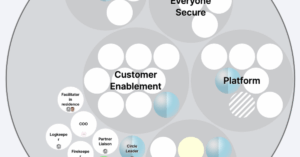Your SaaS is growing and getting ready to scale. Your investors want faster delivery of new features, while staying scalable and with a degree of reliability of the underlying platform. You might be looking at a container platform like Kubernetes to help you move faster. In order to follow best-practices like infrastructure-as-code, you need better operational processes, among other things. It’s time to expand your DevOps skills and practices.
In this article we share the options you may have for upgrading your team for the next level in DevOps practices and skills in the (pre-)scaling phases of a SaaS business.
For each option we’ll give you what we’ve learnt and seen.
Upgrade the existing team
One or two developers on your team express their interest in taking on the DevOps and cloud. They start experimenting, learning and researching.
Why this is great:
- Deep application knowledge from the start so they know exactly where the pains are.
- Expertise is built up in the existing team.
- And last but not least, we’re already paying them so it’s free!
But there are also some pitfalls with this approach:
- Longer lead times and a tendency to reinvent the wheel due to limited expertise and limited hands-on experience leads to.
- Slows down product development as most of the effort goes to DevOps.
- It’s not really that cheap: the combination of the above actually makes it more expensive.
Expand the existing team
Ah no problem you think, “I will just hire a ‘[DevOps person](link to KB)’ then”!
- Work priorities will be aligned as they are part of the core team where they fully share the objectives of the company.
- Knowledge will be in-sourced more easily once you move beyond 1 person.
- The person will be 100% available for your needs and ready to jump on anything right away (or at least, that is what you think).
The challenges with this approach:
- Expensive to if you want to do it right: You want at least 2-3 people to cover for operations and make sure knowledge is spread when people leave.
- Finding and keeping DevOps people is not easy in smaller teams because they usually don’t have enough opportunities to grow.
- Hiring is time and energy-consuming and risky especially for a role you don’t fully understand yet.
Hire freelancer(s)
On to the next option: you hire an independent contractor.
- Get started quickly as they typically have the right expertise and experience from the start.
- Keep the budget under control thanks to a flexible cooperation style.
- Quick results thanks to the work being done in a very focused and tailored way.
Reasons why you might want to reconsider this choice:
- Variable quality: there are definitely a lot of good freelancers out there, but there are also cowboys.
- Freelancers tend to develop every project from scratch and use unproven technologies each time for the sake of learning, which can make projects difficult to evaluate and own.
- Not a long-term solution as the relationships with freelancers are often very transient.
- Not a reliable solution for operations as freelancers usually want to be there only to design, build and hand-over.
Devops-as-a-Service
Skyscrapers offers another approach that combines many of the advances of the other options without any of the disadvantages:
- Knowledge sharing built-in: train your team on the go while going with a professional solution.
- Predictable and budget friendly subscription based pricing.
- No lock-in as all code and documentation is available.
- Get going quickly with a proven solution that is being used today by many of your SaaS peers.
- You focus on your product innovation while we cover for you. You can take over when you are really ready to build your own team.
- End-to-end solution covering maintenance, guidance, operations and constant improvements.
Conclusion
Keep in mind that every situation is different, so your mileage may vary. We’ve seen companies be successful with all options and usually it is more of a moving target over time. To make the right choice, you need to understand your own challenges, limitations and context.
So let’s talk and figure it out together!
Photo by Thomas Bonometti on Unsplash.









